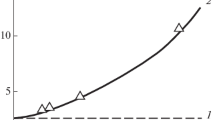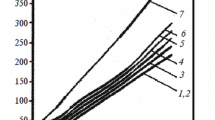Abstract
A correlation between the specific surface of carbon fibers and strength of the boundary layer in a binder has been established. The effect of fibers on the structure formation of a binder has been explained as being a result of the density of fiber reticulation. Its important influence on the rheological properties of binders has been established using the example of carbon fibers. Fibers with a low density of reticulation are shown to affect considerably the structure formation of binders.
Similar content being viewed by others
References
A. N. Muranov, G. V. Malysheva, V. A. Nelyub, I. A. Buyanov, I. V. Chudnov, and A. S. Borodulin, “Investigation of properties of polymeric composition materials around a heterogeneous matrix,” Polym. Sci., Ser. D 6 (3), 256–259 (2013).
N. I. Baurova, “Microstructural investigations of surfaces of destruction of carbon plastic,” Polym. Sci., Ser. D 6 (3) (2013).
I. B. Artem’ev, B. V. Artem’ev, and A. A. Sozontov, “Remote servicing and author supervision of nondestructive testing systems in production,” Remont, Vosstanov., Mod., No. 6, 27–31 (2014).
V. V. Klyuev and N. R. Kuzelev, “Technologies and means of nondestructive testing and technical diagnostics of the Research Institute of Introscopy MNPO Spectrum,” Remont, Vosstanov., Mod., No. 1, 3–6 (2014).
B. V. Artem’ev and I. B. Artem’ev, “Public organizations and community experts as sources of professional knowledge,” Kontrol’, Diagn., No. 6, 61–65 (2015).
A. V. Savinkova, “Heat- and cold-resistant sealants,” in Aviation Materials at the Turn of the 20–21st Centuries (VIAM, Moscow, 1994), pp. 432–440 [in Russian].
L. P. Kobets, “Kinetics of impregnation of carbon and aramid fibers by liquids,” Plast. Massy, No. 9, 18–24 (2007).
V. A. Nelyub, Yu. M. Mironov, M. O. Makeev, et al., “Study the disorderedness extent of the structure of carbon fibers by Raman spectroscopy,” Vse Mater., Entsikl. Sprav., No. 3, 38–42 (2013).
V. A. Nelyub, “Determination of adhesion interaction between carbon fiber and epoxy binder,” Polym. Sci., Ser. D 8 (1), 6–8 (2015).
L. P. Kobets, G. V. Malysheva, and A. S. Borodulin, “Rheological properties of the elastomeric binder system— discrete carbon fiber,” Materialovedenie, No. 5, 47–51 (2015).
Author information
Authors and Affiliations
Corresponding author
Additional information
Original Russian Text © V.A. Nelyub, A.S. Borodulin, L.P. Kobets, G.V. Malysheva, 2016, published in Klei. Germetiki. Tekhnologii, 2016, No. 2, pp. 19–23.
Rights and permissions
About this article
Cite this article
Nelyub, V.A., Borodulin, A.S., Kobets, L.P. et al. A study of structure formation in a binder depending on the surface microrelief of carbon fiber. Polym. Sci. Ser. D 9, 286–289 (2016). https://doi.org/10.1134/S1995421216030187
Received:
Published:
Issue Date:
DOI: https://doi.org/10.1134/S1995421216030187




